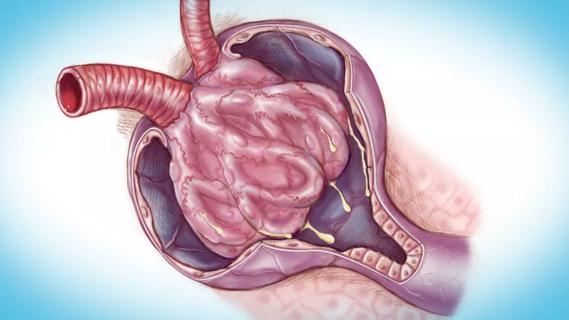Helps pinpoint risk of disease progression and death in this heterogeneous population.

The application of machine learning consensus clustering to multidimensional phenotypic data on 2,696 patients in the Chronic Renal Insufficiency Cohort (CRIC) revealed three distinct subgroups of patients with different risks for chronic kidney disease (CKD) progression, kidney failure requiring replacement, cardiovascular events and death independent of established CKD risk factors.
Advertisement
Cleveland Clinic is a non-profit academic medical center. Advertising on our site helps support our mission. We do not endorse non-Cleveland Clinic products or services. Policy
The physicians involved in this study say that using this novel approach for staging CKD could be a major advance in the move toward individualization of patient care.
“The identification of clinically meaningful subgroups among patients with CKD is an important step toward bringing precision medicine to nephrology,” says Cleveland Clinic nephrologist Hernan Rincon-Choles, MD, a co-author of the multi-institutional study published in the Journal of the American Society of Nephrology.
Dr. Rincon and colleagues explored the concept in hopes of identifying clinically distinct CKD subgroups that could add to understanding the heterogeneity of CKD and its causes, leading to better disease management.
“Staging CKD by eGFR and urine albumin-creatinine ratio does not fully capture underlying patient heterogeneity. The majority of causes for CKD are unknown. Phenotyping can reveal different and more reliable CKD clusters and underlying disease pathologies, and this knowledge will help us understand the mechanisms for disease progression,” he says.
More than 822 patient variables are recorded in the CRIC database. The researchers selected 72 clinically available and novel factors on the basis of literature review for those that were most likely to be clinically relevant to CKD. The selected variables included sociodemographic data, health status and behavior, biomarkers of inflammation, lipid metabolism, cardiac function, kidney function, bone and mineral metabolism, diabetes and medications.
Advertisement
When consensus clustering was applied to this data, three unique CKD subgroups with markedly different risks of important clinical outcomes appeared.
Cluster 1 (n=1203) was comprised of patients with relatively favorable levels of bone density and cardiac and kidney function markers, lower prevalence of diabetes and obesity and use of few medications.
Patients with higher prevalence of diabetes and obesity who used more medications formed cluster 2 (n=1098).
Patients with less favorable levels of bone mineral density, poor cardiac and kidney function markers and higher inflammation levels comprised cluster 3 (n=395).
When linked with future clinical endpoints, these three subgroups were associated with different risks of CKD progression, cardiovascular disease and death.
Furthermore, patient heterogeneity among predefined subgroups with similar baseline kidney function emerged.
Over a median follow-up of nine years, 900 individuals developed the composite outcome of CKD progression; 689 experienced kidney failure requiring renal replacement therapy; 469 developed heart failure (HF); 460 developed the composite outcome of myocardial infarction (MI), stroke and peripheral arterial disease (PAD); 720 developed the composite outcome of MI, stroke, PAD and HF; and 724 died.
Kaplan-Meier survival plots showed clusters 1,2 and 3 were associated with low, medium and high risks for these clinical outcomes. Additionally, cluster 2 was independently associated with increased risk of CKD progression.
Advertisement
While the potential value of this approach generated a great deal of excitement, more work must be done before it can be used to make treatment decisions.
Future studies are needed to validate the identified clusters and investigate CKD subgroups by incorporating novel biomarker data to identify subgroup-specific therapeutic targets. Also, software that enables clinicians to apply consensus clustering to different groups of patients must be made readily available.
Nevertheless, a crack in the wall preventing nephrologists from understanding the characteristics of CKD unique to individual patients has appeared. It’s only a matter of time before the wall collapses. In addition to this approach, several of Dr. Rincon’s Cleveland Clinic colleagues—John Sedor, MD, John O’Toole, MD, Leslie Bruggeman, PhD, Emilio Poggio, MD and Jonathan Taliercio, DO, principal investigator for the CRIC Study at Cleveland Clinic—are involved in the NIH-funded Kidney Precision Medicine Project, using kidney biopsy, genetics and proteomics to identify novel pathways leading to kidney disease.
“It’s only a matter of time before we will be able to individualize therapy to specific patients,” Dr. Rincon says.
Advertisement
Advertisement

Proteinuria reduction remains the most important treatment target.

IgA nephropathy is a relatively common autoimmune glomerular disease that can be diagnosed only by biopsy

Authors summarize the recent evidence and offer two clinical scenarios

Key considerations when diagnosing and managing severe hyponatremia

Clinicians should individualize dosing practices based on patient risk factors and preferences

Fully-automated process uses preop CT, baseline GFR to estimate post-nephrectomy renal function

Identifying barriers in the renal genetic assessment of Black patients

Getting patients to their goal blood pressure